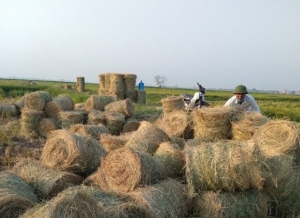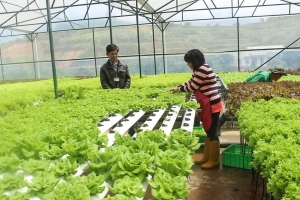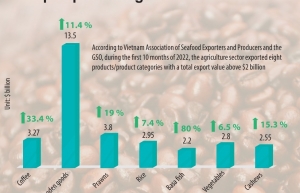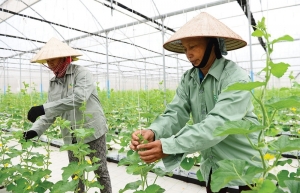Agricultural sector serves as important economic driver
At a cabinet meeting in Hanoi on August 5, Prime Minister Pham Minh Chinh stated that the government will not change the growth target of 6.5 per cent for 2023 and strive to reach an economic expansion of about 9 per cent in the rest of the year.
 |
| Phung Duc Tien - Deputy Minister of Agriculture and Rural Development |
In this spirit, more than just a pillar of support, the agricultural sector will also work with authorities at all levels, all sectors, the political system, and individuals and businesses towards better performance across all fields in order to attain this target.
The agricultural sector is making an effort to complete its growth goals, contributing to the growth target of the whole economy. For 2023, the agricultural and rural development sector targets GDP growth of 3 per cent, agro-forestry-fishery export revenues of $54-55 billion, the rate of new-style rural areas at 78 per cent, and forest coverage stable at 42 per cent.
The Ministry of Agriculture and Rural Development (MARD) judged that there have been many bright tones in recent months to create a foundation to reinforce the trust in this target. In the first half of 2023, the agro-forestry-fishery sector maintained a stable growth rate, ensuring the supply of food and essential goods. The disbursement progress of public investment capital has improved markedly, and the balance of trade in goods has maintained a surplus.
Between January and June, the agricultural products export turnover touched $24.59 billion. The sector increased by 3.07 per cent, contributing 9.28 per cent to GDP in the first half of 2023.
Meanwhile, across the first seven months, the total export turnover of this sector reached $29.13 billion. The figure for July only was $4.62 billion, up 5.3 per cent on-year. In several products witnessed an export value of over $1 billion each, including coffee, rubber, rice, vegetables, cashew nuts, shrimp, and wood.
To achieve the growth target for the whole year, the contribution of the turnover of agro-forestry-fishery products is important. In which, forestry and fisheries account for a large proportion of the structure of export turnover.
We can hope for a bright picture of forestry and fisheries in the remaining months of this year because the export picture of the agricultural industry gradually reveals bright colours thanks to the gradual recovery of orders from foreign partners.
According to the Vietnam Association of Seafood Exporters and Producers, Vietnam's largest seafood export market, the US, is in recovery due to cooling inflation, reduced inventory levels, and increased demand for holiday services. This helps seafood export turnover to this country is expected to increase by 40-50 per cent over the same period.
Regarding the forestry sector, export orders for furniture started to increase again from the end of the second quarter. The wood industry is still optimistic that it can reach the export milestone of $14 billion by the end of the year, when businesses begin to receive new orders.
To have a strong recovery in these two key industries, businesses and manufacturers need to be more proactive in preparing raw materials and signing orders, to take full advantage of opportunities when the markets of other countries prosper.
In terms of the MARD’s mission in the last months of the year, the agricultural sector will continue to focus on developing ecological agriculture, modern rural areas, and civilised farms while considering farmers as the centre, agriculture as the impetus, and rural areas as the foundation for the sector’s development.
Furthermore, the ministry will pay attention to promoting brand building, digital transformation, and the green transition and circular economy. It also should connect with cultural and tourism development; diversify products, markets, and supply chains; and improve product quality.
Along with the particular activities of the sector, the MARD will continue to collaborate with other ministries, sectors, and localities to link producers with consumers; optimise free trade agreements; continue removing barriers to enter new markets; and pay due attention to the domestic market.
 | Agricultural sector urged to scale up by-product use Vietnam’s biomass potential from by-products has been assessed to surpass 160 million tonnes annually and is valued at around $46.5 billion. However, only a minor part of this potential is being tapped, experts have said. |
 | Challenging road ahead for agriculture startups Vietnam’s innovation startup ecosystem is forecast to see an investment of $2 billion, according to the Vietnam Open Innovation Ecosystem Report 2022, and aspiring startups are making great strides to bring distinct products from their homeland to supermarket shelves at home and abroad. |
 | Sharp export rise backs up agricultural trade surplus The Vietnamese agricultural sector has performed well thanks to growing demands for products and enterprises’ performance bouncing back. |
 | International aid for carbon mitigation now on the table International institutions, including the World Bank, are willing to provide financial aid for Vietnam’s agricultural sector to complete carbon emissions mitigation. |
What the stars mean:
★ Poor ★ ★ Promising ★★★ Good ★★★★ Very good ★★★★★ Exceptional
Related Contents
Latest News
More News
- Six localities record double-digit growth as regional performance diverges in 2025 (January 06, 2026 | 18:00)
- E-commerce market undergoes transformation amid rising competition and regulation (January 06, 2026 | 17:54)
- Vietnam’s industrial output hits seven-year high in 2025 (January 06, 2026 | 17:47)
- GELEX’s credit rating outlook upgraded to 'Positive' by VIS Rating (January 06, 2026 | 16:49)
- Finance sector lays firm groundwork for 2026 after major reform (January 06, 2026 | 15:30)
- Vietnam’s seafood exports surpass $11 billion in 2025 (January 06, 2026 | 08:51)
- Vietnam GDP posts second-strongest growth since 2011 (January 06, 2026 | 08:35)
- Double-digit GDP growth within reach with shift to higher-value expansion (January 06, 2026 | 08:33)
- Takeda Vietnam awarded for ongoing support of Vietnam’s sustainability efforts (December 31, 2025 | 21:00)
- Vietnam's retail market tops $269 billion in 2025 amid e-commerce boom (December 31, 2025 | 19:00)

 Tag:
Tag:





















 Mobile Version
Mobile Version